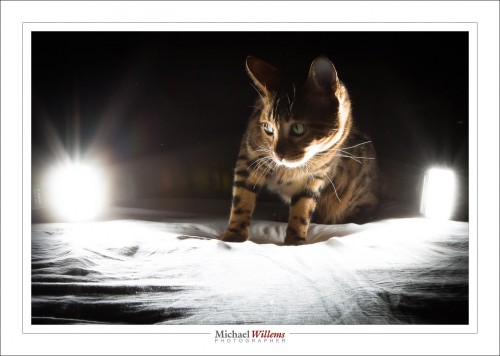As seen in the previous post: Mau, just now:
So what are the salient technical points of this photo?
- I have two flashes aiming toward the camera and toward Mau Mau from the back, providing back- and rim lighting.
- Back- and rim lighting provide “3-D” modelling and drama, and light the whiskers well.
- But the white bedsheets (and I!) reflect enough back so there is some forward lighting also.
- Camera: manual mode, 100 ISO, 1/200 sec, and f/22:
- So that is the “darkest” possible ISO, the “darkest” possible shutter speed (“sync speed”), and the “darkest” possible aperture this lens offers; alll this to completely kill the bright ambient light (and at this close distance the flashes are super bright, so that’s not a problem).
- I used a Yongnuo YN622C-TX wireless controller on the camera, and a YN622C connected to each one of the flashes.
- These flashes have to be 430EX MkII or 580EX or 600EX, or equivalent: the old 430EX with the switch does not work here. Much as I like the switch, this is a situation where electronically setting the wireless mode is a must have.
- Although this setup supports TTL, I used manual power setting for the flashes, 1/16 power worked fine in this case (trial and error). Manual power setting is the way to go, if you have any control over the environment.
- You should lose any filters you may have on the lens: they will often increase flare to an unacceptable level. They certainly will not make the picture better.
- The lit eye is in sharp focus; of course at f/22 there is quite a lot in focus. Eye and whiskers are essential.
As you see, beyond the obvious, rather a lot of thinking can go into a simple picture. And few of these are “the only way to do it”. That is why photography is such a cool artistic endeavour.
So if few of those are “must do this way” points, why list them?
Because it is more important that you think about all these things than what you think about them. In other words, an analytical approach to photography helps you create repeatable art, where a photo works a certain way because you want it to, rather than “by accident”.


Well said Michael, need some Photoshop training, know anybody that can help? LOL!
I used to teach PS, but I no longer use it, so I am too rusty. I do everything in Lightroom now. (And save 80% of my post-time as a result).